My Garden: A Naturalistic Garden Welcomes the Birds and the Bees
Welcoming all that can fly in, this natural garden is home to birds, bees, bugs, and even bats. It’s also populated with native and ornamental plants that are both beautiful and kind to the environment.A common mistake gardeners make is adorning their flower beds with plants that appeal to them visually with little thought given to their impact on the environment. Yet it’s possible to have the best of both worlds—a garden that not only delights the eye, but also benefits the native habitat.
Featured in: Garden Design's Top 10 Garden Trends for 2022 ("Gardening for Wildlife")
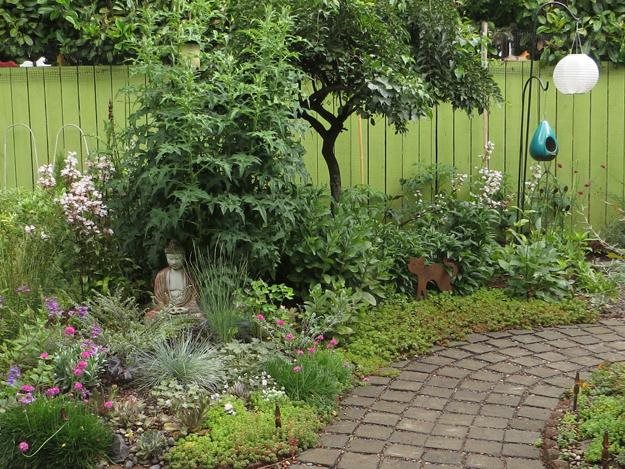
A paver walkway meanders through the back garden, under the watchful eyes of a concrete Buddha, which sits among Echinops ritro. Also in the mix are Hebe ‘Quicksilver’, Penstemon ‘Husker Red’, and a variety of Pacific Northwest natives such as Sedum oreganum, Juncus effusus, Armeria maritima, and Penstemon serrulatus.
That ideal blend of beauty and sustainability was achieved by Tamara Paulat in her charming Pacific Coast garden in Portland, Oregon. Her entire yard (which she calls “Chickadee Gardens”) is populated with a carefully chosen mix of native and ornamental plants that are kind to the environment while echoing the architectural style of her 1929 Spanish Revival home.
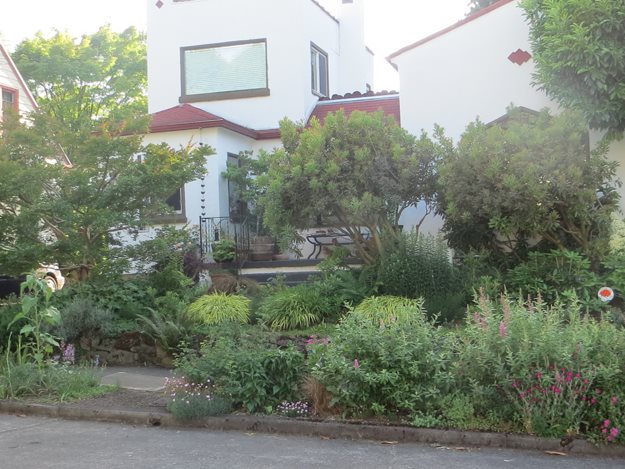
Paulat’s Spanish Revival style home is unusual in the Pacific Northwest, and she has selected plants that enhance its architecture yet thrive in their native habitat. Spiraea douglasii with fluffy pink blooms were planted as an alternative to invasive butterfly bush or buddleia. The two small trees, which were there when Paulat bought the house, are Myrica rubra-relatively unknown around the West Coast but common in Japan. She simply pruned them to bring in more light and air circulation. An Acer circinatum (vine maple) in a terra-cotta pot on the front porch echoes both the Spanish influence of the home while being native to the Pacific Northwest.
“Everything has to pull its weight around here,” says Paulat, who is platinum certified with the Portland Backyard Habitat Certification Program. “It is either a native plant that provides a habitat for insects and birds or an ornamental that is non-invasive, adaptable to our area, and provides some sort of benefit for wildlife in the form of food, shelter, seed, or building material.”
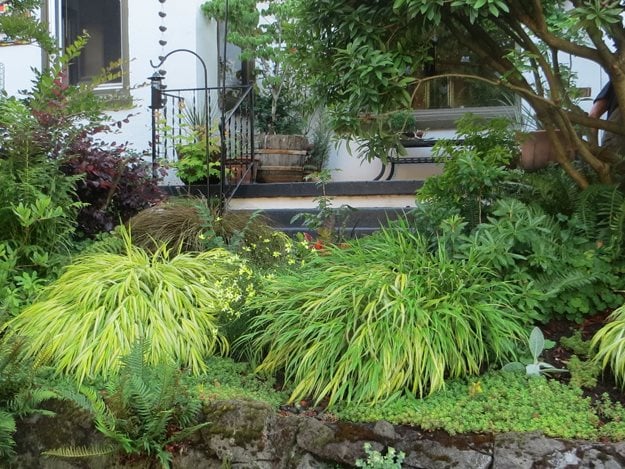
Hakonechloa macra ‘Aureola’ in the front garden gets morning sun and afternoon breezes. Native Sedum oreganum serves as a groundcover underneath native sword ferns that have naturalized in the rock wall. Coreopsis ‘Moonbeam’ tucked in between attracts pollinators.
When Paulat began planting her garden five years ago, her mission from day one was sustainability. She uses native plants whenever possible and shuns the use of pesticides. To encourage pollinators and provide a welcome refuge for insects and birds, her garden is teeming with bird feeders and bird houses, a bat house, and mason bee houses. She also has installed two eco-friendly rooftop gardens (one above her enclosed porch and the other over her garden shed) and has removed her concrete patio, replacing it with pavers to provide greater water permeability.
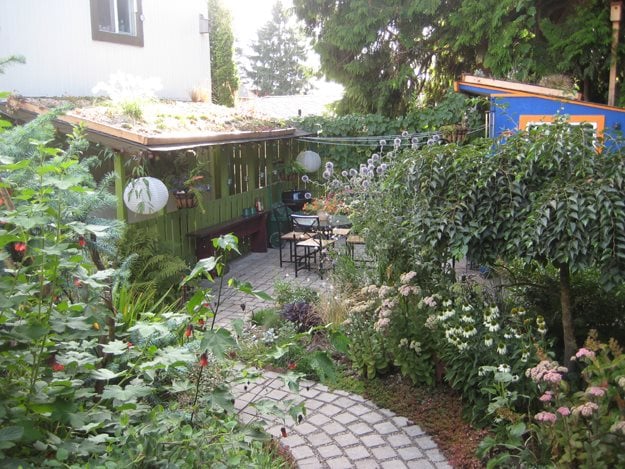
Eco-friendly rooftop gardens were installed on the enclosed back porch (left) and garden shed (right). Broad strokes of Echinacea purpurea ‘White Swan’ and Sedum ‘Matrona’ along the walkway provide color through late summer and early fall, while Abutilon in the foreground are favorites for hummingbirds. The tree on the right, Styrax japonicus, is covered with sweet-smelling sweet white blooms in the spring.
“I am completely organic,” she says. “I want to garden knowing that what I leave will be better and healthier than when I started. I want to improve the space and soil I started with and leave the birds and bees a little better off to reverse whatever damage I have done unknowingly.”
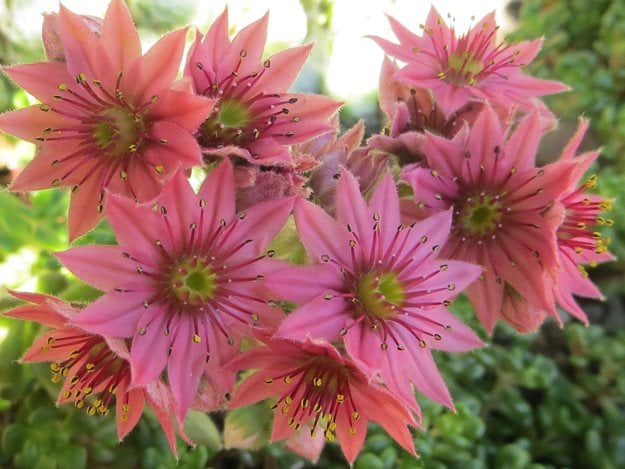
The spunky blooms of Sempervivum arachnoideum stand out against a backdrop of Sedum oreganum.
Some of Paulat’s favorite plants include Sedum oreganum, Aruncus dioicus, Armeria maritima, Ribes sanguineum, Oxalis oregana, Spiraea douglasii, Heuchera 'Marmalade', Hebe ‘Champion’, Agave ‘Blue Glow’, and Adiantum aeluticum. Ornamentals, such as Yucca rostrata, Rosa ‘Eden’, planted for its beautiful rose hips in the fall, provide both visual and wildlife benefits. She meticulously selects plants that work well in each “microclimate” in her yard, which has both full sun exposure and shaded areas. Her rule of thumb is finding the right plant for the right place.
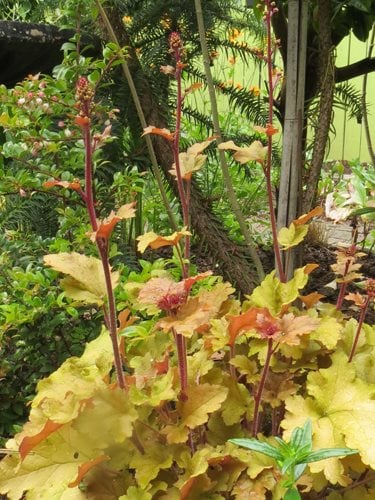
One of Paulat’s favorite plants is Heuchera ‘Marmalade’. “It has proven to be not only sun-tolerant, but shade and drought tolerant too. It just gets bigger and better every year,” she says.
“Just because native plants are in your garden does not mean they are zero maintenance. There are shade-loving perennial natives as well as chaparral natives and hot, hot desert natives within a short distance of one another at my home. Some like wet woodland conditions, others hot and dry. Give them what they would find in in their natural habitat,” she says.
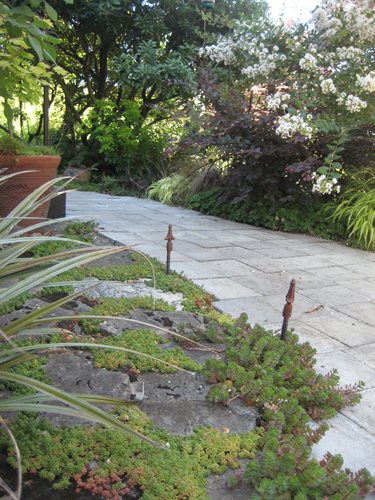
A variety of sedums and Astelia nivicola ‘Red Gem’ line the path up to Paulat’s front door. The flowering tree on the right is Lagerstroemia x ‘Natchez’.
To read Paulat’s blog, which chronicles her life in the garden, visit Chickadeegardens.blogspot.com.
See more Pacific Northwest gardens
RELATED:
10 Ways to Start Building a Garden for Wildlife
Native Plants - How & Why to Grow Natives
